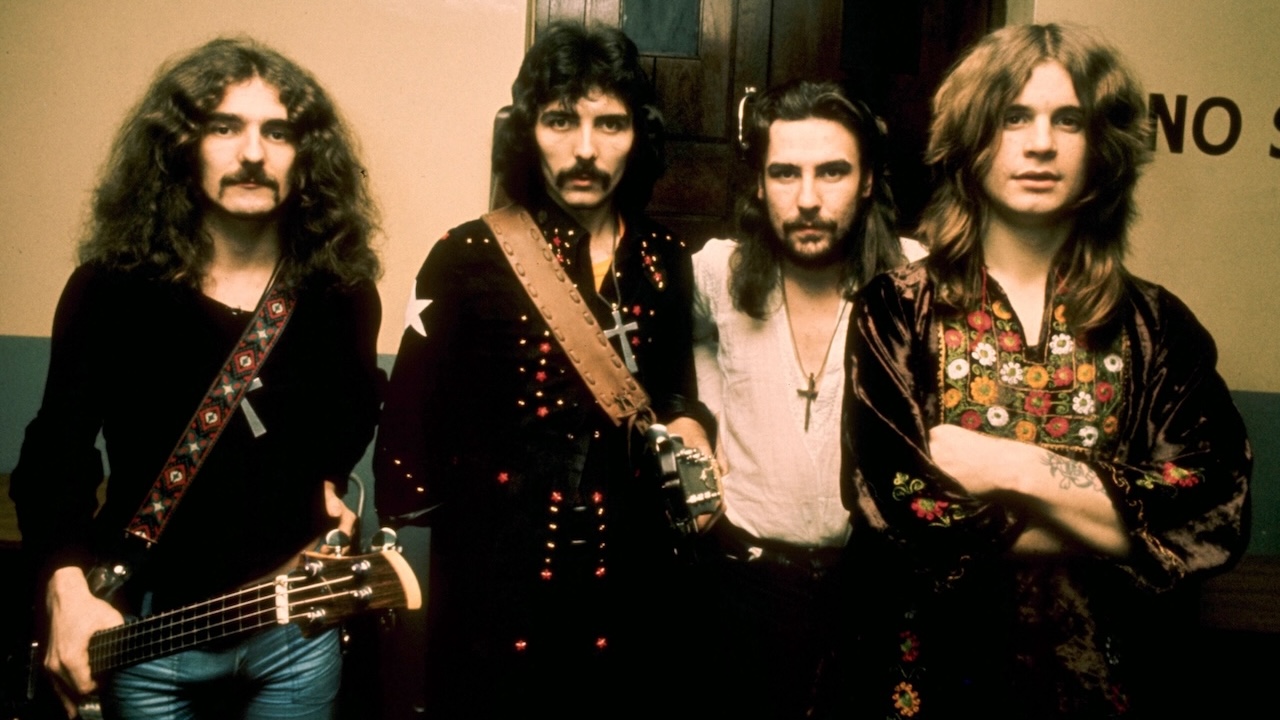“It’s become a bad habit. I bought a 1955 Tele and turned it over to carve my initials into the back. My friend screamed, ’Don’t do that!’” Kirk Hammett on his favorite Metallica solo and tone – and his most prized purchases from other guitar heroes
The Metallica great is celebrating his remarkable guitar collection in a new Gibson book. He explains how he came to own prized guitars from John Frusciante and Michael Schenker – and why he doesn’t cut cash deals anymore

You could say Kirk Hammett knows a lot about guitars.
He’s been collecting them for over four decades, with many of his finest specimens exhibited on last year’s Gibson TV interview – part of an ongoing series presented by the company’s Director of Brand Experience Mark Agnesi.
Now a 400-page coffee table book takes that concept one step further, giving fans a closer look at some of Hammett’s most prized vintage rarities, which famously include the 1959 Les Paul Standard once owned by Peter Green and Gary Moore and the 1979 Flying V heard on Metallica’s most impactful releases.
If you ask the man how exactly he caught the bug, he’ll tell you it was always there deep inside of him...
“I’ve always been a collector,” he smiles, talking to GW from his home in Hawaii. “At first it was comic books, monster magazines and whatnot. I’ve always been a collector of something. When I started playing guitar, I’d look at books and magazines and see all these wonderful Flying Vs and Strats, thinking to myself, ‘Wow!’
“I remember going to Guitar Center in San Francisco and seeing a Korina V but they put it on the top rack, like 15 feet up! I was thinking ‘One day I’ll have enough of a say to ask if I can plug it in and the staff will let me.’”
If the Kirk Hammett we’re speaking to right now walked into that guitar shop, they wouldn’t just let him play whatever his heart desired; they’d close up early and give him the kind of privacy only afforded to the rockstar elite.
All the latest guitar news, interviews, lessons, reviews, deals and more, direct to your inbox!
It would be a dream experience for the rest of us mere mortals, but just another day in the life of a Metallica member. He’s humble enough to acknowledge how times have changed, and in more ways than one...
“Back then, vintage guitars were so frickin’ cheap,” continues Hammett. “That Korina V was only $2,400. Now it would be 10 times that amount just for a cheap one and 100 times that for a not-so cheap one!
“As soon as I started touring with the resources to buy, probably around 1988 0r 1989, I started acquiring rare instruments. Me, James [Hetfield] and Jason [Newsted] would go to dealers in the Midwest and walk away with 10 cases each! The next day would be hilarious because we’d walk into our dressing room and there’d be all these random guitars.”
Not all deals are the same… What’s the weirdest situation you’ve found yourself in?
“A lot of the major guitars in this book, like the Explorer, prototype Flying V and the 1958 Les Paul Standard came from a big package deal 15 years ago. A seriously big deal. The guy didn’t want any trades; he wanted cash.
“It was so much that I had to sell guitars and movie posters to raise enough. Another part of the deal was that I wasn’t allowed to talk about it for five years. I said, ‘Whatever!’ because I was used to dealers acting in that way.
“With movie posters you deal with people and ask, ‘Hey do you have this one?’ and they deny it. You ask again and eventually they come back with, ‘Alright, what would you give me for it?’ It’s the same friggin’ game with guitar dealers.
“A lot of people don’t want others to know what they have in their collections, nor do they want people to know what’s coming in because they think it’s some kind of business strategy. I can respect that – but I don’t condone it. I think everything should be out in the open.”
So what do you think is the total value of your collection?
“I dunno... at least a nice house somewhere! Some of these guitars I’ve had for 20 or 30 years. I didn’t buy them for what they’re currently valued at – thank God, man! Now you have to be ready to spill $250,000 just to get a dealer to answer the phone.
“The time of me spending that much on an instrument is long gone. If I do find something, I’m instantly thinking about trades. It’s exactly what I used to do with comic books and movie posters. My strategy is the same: find the most unique models and coolest rarities and then just go for it.

“I would network and ask around, just doing whatever I can to find certain things. That’s how I’ve ended up with the collection I have. It’s the rarest, coolest and most unique stuff everyone wants.
“I’d rather do trades than cash deals; with trades, everyone walks walk away smiling. Cash deals don’t do that; you walk away feeling empty. It’s no different to purchasing a friggin’ milkshake or whatever.”
I have Michael Schenker’s main Flying V… I used to stare at it I was 15 years old. Now I own it
A few years ago, there was a story about how James had carved ‘No. XII’ onto one of his 1959 Les Paul Standards. We reckon some collectors are still having nightmares about that.
“Even I’ve gotten into the habit of doing that! Over the last five years, I’ve started carving my initials into the back of guitars I really like. I’ll look at my stand and see three purple metallic Ouijas, making me wonder, ‘Which one do I grab?’ I’ll turn them over, and if my initials are on the back, that’s the one!
“It’s started to become a bad habit. I bought a 1955 Tele – well, actually an Esquire – and I turned it over to carve my initials into the back, but then my friend screamed, ‘Don’t do that!’ I had to thank him for reminding me. I’ve got OCD and ADD. Sometimes I will compulsively do things and later wonder why.”

Another interesting guitar in the book is the 1961 three-pickup SG once owned by John Frusciante, which was played on the Red Hot Chili Peppers’ hit Otherside and used in the video for Fortune Faded. It’s a surprise because most people wouldn’t connect your bands.
“I’m honored to have a guitar that John owned. I like John; he’s a great guy that’s super-eccentric, just like I am. He’s a great player too. I’d been looking at SGs for a long time and it had been hard to find good ones. I managed to find a handful of great ones and I love them.
My lead sound on Load is the best tone I’ve ever gotten. I’m still chasing that sound
“I only started using SGs around the Load era. That white two-pickup SG in the book is something else. It was Les Paul’s SG – he actually played it on an album. That was crazy, because when I first got that guitar I didn’t know who’d owned it.
“It’s weird how celebrity instruments over the last 10 or so years have gravitated towards me. I have Michael Schenker’s main Flying V that he played on his first four albums.
“I used to stare at it when I was 15 years old, on the back of UFO’s Force It album. I’d be thinking, ‘What an amazing instrument!’ Well, now I own it. It’s in the book, painted like a V-2 rocket, so Michael probably wouldn’t recognize it.”

You were recently gifted a Triplecaster by Jack White. What did you make of it?
“I love that thing. It has all these nice little toys attached to it, like killswitches or whatever, so you can make the guitar beep like Tom Morello. It has what looks like a Bigsby tremolo arm – I yank on that thing hard, and it actually stays in tune. I’m so impressed by that feature.
“It has this weird combination of pickups. I love P-90s; it has one of those, and some other strange things. Jack gave me that guitar because I sent him a Greeny. He’s played the original. I turned up at one of his shows with Greeny and said, ‘Bro, check it out – play her on stage!’ And he used that guitar for a few songs.
“When the replicas came out, I sent him one because I knew he’d dig it. So a couple of months ago, I got a text from him saying, ‘You’re gonna get a package in the mail.’ He occasionally sends me his Third Man pedals, which are totally psycho; I love them. But then a guitar case showed up, and when I opened it up, I was so happy!”

Your rig has evolved over the years, just like your playing. What’s the greatest tone you’ve ever gotten?
“I would have to say my lead sound on Load is the best tone I’ve ever gotten. I’m still chasing that sound. It was the 1961 SG with PAF pickups going out to 20 amps all blended together. Okay, I don’t know if it was 20, but it was definitely more than five.
“My second favorite is my lead sound on Kill 'Em All. I talk to Lars about that killer tone all the time. It was just my Flying V with EMG pickups and my Tube Screamer going through James’ legendary fuckin’ Marshall that got stolen in Boston.
“The sound had this pureness that felt so real. It wasn’t super-processed or overworked. It sounded natural and fit the music. Magic!”
Another tough question. What’s the greatest solo you’ve ever recorded?
“The solo in Fuel was done on the green Strat from the I Disappear video. I love that guitar so much. I still have it; that thing just feels like an old friend. So I really love how that solo came out. But it’s a tough question, bro.
“I think I’ll say it’s the one from Hero of the Day. Every note counts and fits perfectly. I feel like everything is in its right place and the solo lifts the song to another level, which I always try to do – even if I’m not always successful. The track has a different level of intensity afterwards.
“There’s another solo I really like – I’ve tried to relearn it and I just can’t fuckin’ nail it. It’s the one from The Unforgiven III. Some of the playing is out of time, but it sounds super-effective.
“It can happen: you’ll play something out of time but it just friggin’ works. It’s crazy. And because it’s out of time, it’s hard for me to relearn because I always want to play in time. It feels unnatural, even though I’m the one who originally played it!
“I’m a big fan of playing from the heart. I love seeing technique – a lot of new younger players have both hands on the neck, doing all this crazy stuff. I also dig all those percussive acoustic players. I love all that stuff to death. But, man, most of all I just love hearing simple solos that sing.”
- The Collection: Kirk Hammett is available now from Gibson Publishing in Standard hardcover, Deluxe slipcase and Custom boxset editions. See Gibson.com for more info.
Amit has been writing for titles like Total Guitar, MusicRadar and Guitar World for over a decade and counts Richie Kotzen, Guthrie Govan and Jeff Beck among his primary influences as a guitar player. He's worked for magazines like Kerrang!, Metal Hammer, Classic Rock, Prog, Record Collector, Planet Rock, Rhythm and Bass Player, as well as newspapers like Metro and The Independent, interviewing everyone from Ozzy Osbourne and Lemmy to Slash and Jimmy Page, and once even traded solos with a member of Slayer on a track released internationally. As a session guitarist, he's played alongside members of Judas Priest and Uriah Heep in London ensemble Metalworks, as well as handled lead guitars for legends like Glen Matlock (Sex Pistols, The Faces) and Stu Hamm (Steve Vai, Joe Satriani, G3).
You must confirm your public display name before commenting
Please logout and then login again, you will then be prompted to enter your display name.



